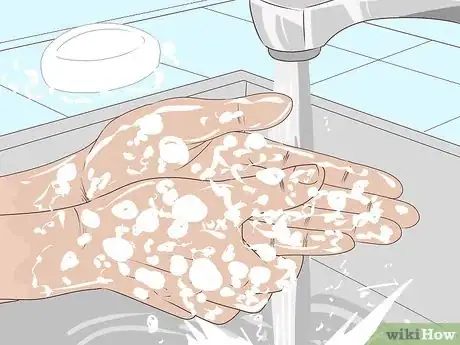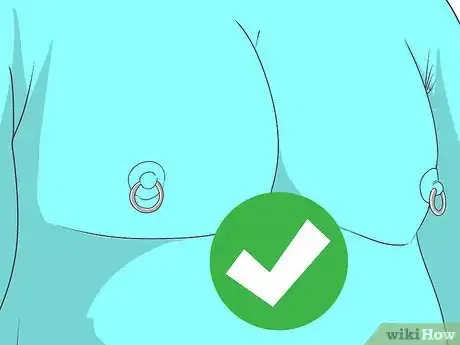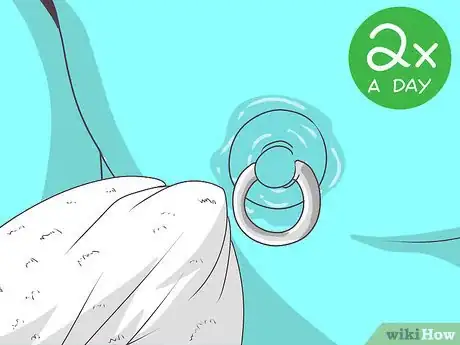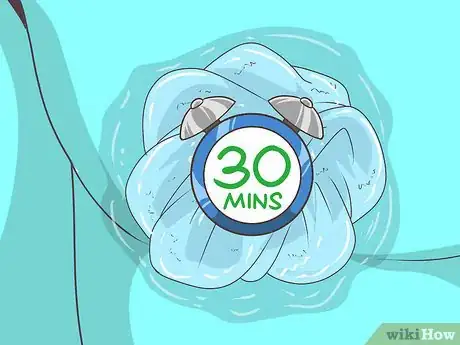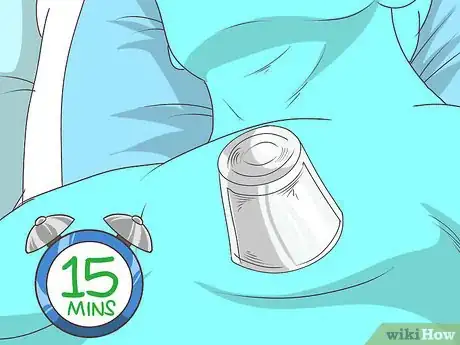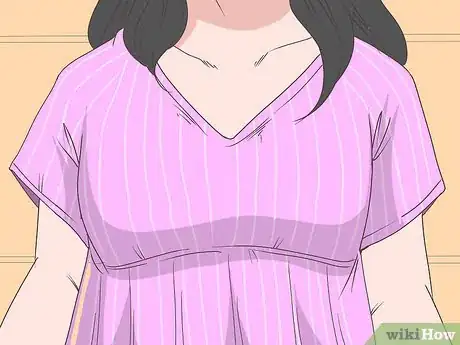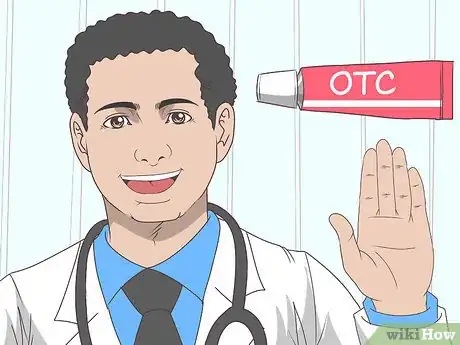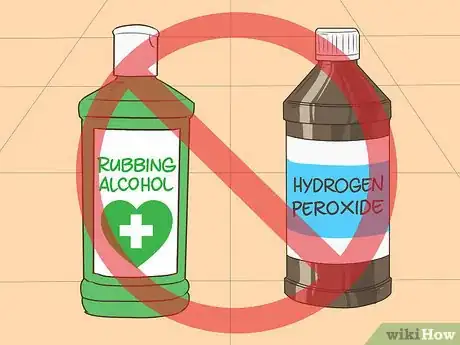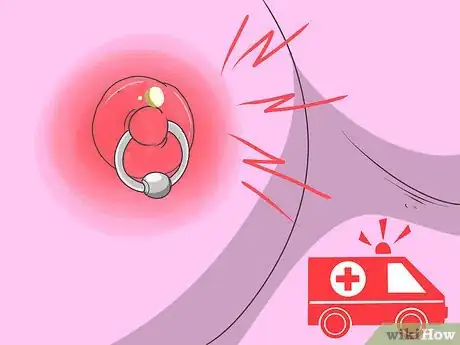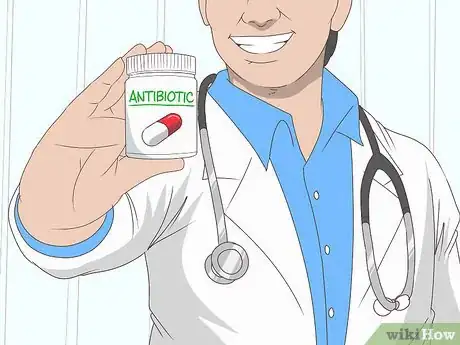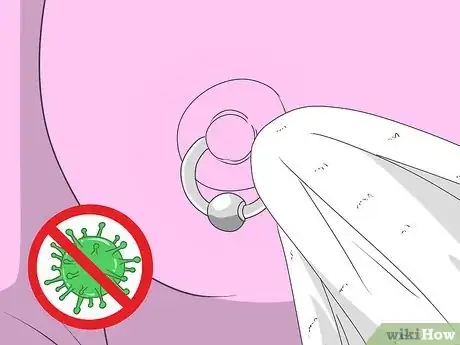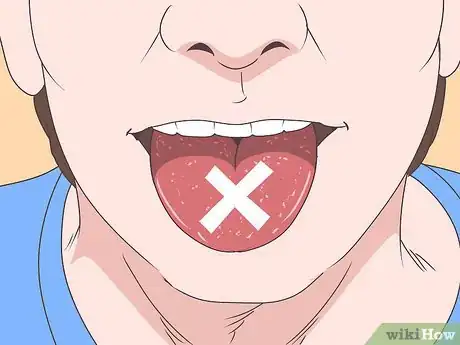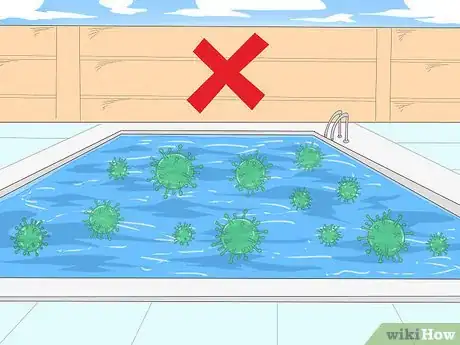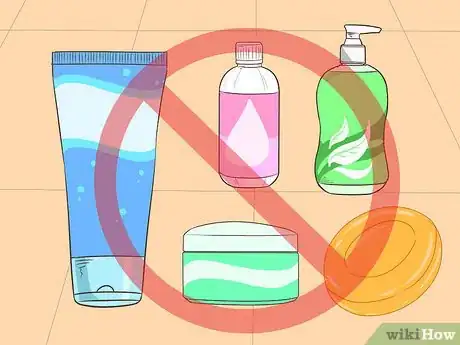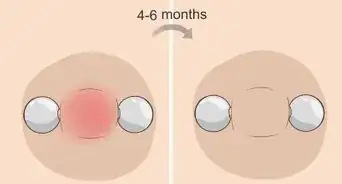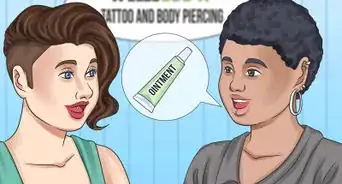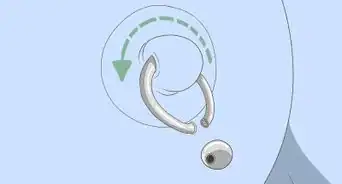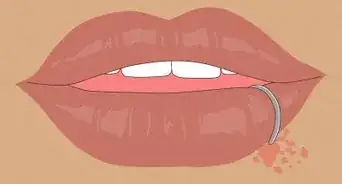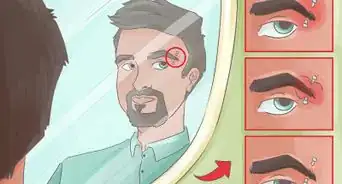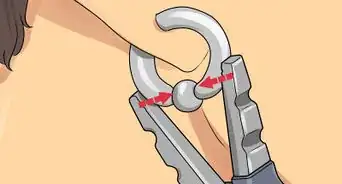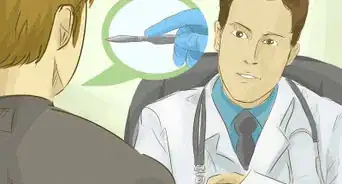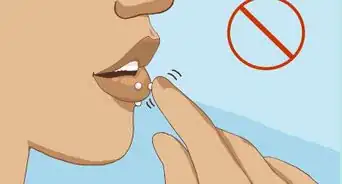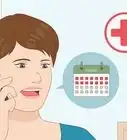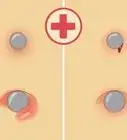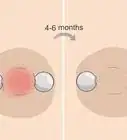This article was medically reviewed by Luba Lee, FNP-BC, MS and by wikiHow staff writer, Danielle Blinka, MA, MPA. Luba Lee, FNP-BC is a Board-Certified Family Nurse Practitioner (FNP) and educator in Tennessee with over a decade of clinical experience. Luba has certifications in Pediatric Advanced Life Support (PALS), Emergency Medicine, Advanced Cardiac Life Support (ACLS), Team Building, and Critical Care Nursing. She received her Master of Science in Nursing (MSN) from the University of Tennessee in 2006.
This article has been viewed 361,683 times.
Even with the best care, your nipple piercing can get infected, which causes redness, pain, and swelling. Dealing with an infection can be frustrating and scary, but your symptoms are treatable. It’s best to see your doctor if you suspect an infection, but you can use home treatments to address your symptoms. However, if your infection doesn’t start to improve within a week or gets worse, you need to see your doctor. Additionally, take care of your piercing so a reinfection doesn’t occur.
Steps
Using Home Treatments
-
1Wash your hands with soap and water before treating the piercing. Keeping your hands clean will prevent you from accidentally introducing dirt and bacteria into the piercing. Before handling your nipple piercing, wash your hands thoroughly with soap and warm water.[1]
- When you’re done, dry your hands with a clean towel or paper towel.
-
2Leave in your piercing so that the discharge can drain. When you remove your piercing, your skin will start to close. This can trap discharge and pus under your skin, which can cause an abscess. This makes your infection worse and harder to treat. Leave your piercing in your nipple until your infection heals or your doctor tells you to take it out.[2]
- If you’re having a bad reaction to the nipple jewelry you’ve chosen, then your doctor may recommend changing the piercing. This way, your piercing will stay open so it can drain. If your doctor recommends this, go back to your piercer to get the nipple ring changed.
Warning: If your doctor tells you the piercing needs to come out or be changed, then go to your piercer to have it removed. Don’t try to remove it yourself.
Advertisement -
3Clean your nipple piercing twice a day to help the infection heal. Wash your hands with soap and warm water. Then, wet your nipple with warm water and gently cleanse the area with a mild, fragrance-free soap. Rinse away the soap with warm water, and follow up with a saline rinse. Finally, pat the area dry with a clean, dry towel.[3]
- You can buy a saline rinse over-the-counter, or you can make one by adding 1 teaspoon (5 g) of salt to 1 cup (240 mL) of purified water.
- The best time to clean and care for your piercing is after a shower.[4]
-
4Use a warm compress for 15-30 minutes for inflammation and drainage. Soak a clean rag in warm water, then drape it over your nipple. Leave the compress in place for 15-30 minutes before removing it. Finally, pat your nipple dry.[5]
- You can use a warm compress every 2-3 hours as you desire.
- After you use the rag, put it in the laundry. Use a fresh, clean rag every time you use a compress.
- Avoid using cotton balls for this purpose or for cleaning your piercing, since the fibers can get caught in the piercing and make the infection worse.[6]
-
5Apply a cold compress for 15-30 minutes to reduce pain and swelling. Fill an ice pack with ice and water. Cover your nipple with a towel to protect it from the cold. Then, position the ice pack on top of the towel, directly over your nipple. Hold the ice pack in place for 15-30 minutes. Check your skin every few minutes to make sure it’s not getting too cold.[7]
- You can use your cold compress every 2-3 hours, as needed.
- If you experience any discomfort, remove the cold compress and let your skin return to room temperature.
- Always place a towel or a piece of clothing between the ice and your skin. Otherwise, you may accidentally damage your skin with the ice.
Variation: If you don’t have an ice pack, you can use a clean rag instead. Soak the rag in cold water. If you have time, place it in your freezer for up to 15 minutes, as well. Then, place the rag over your nipple. If it feels too cold, use a towel to protect your skin.
-
6Soak your piercing in a sea salt bath for 5-15 minutes twice a day. Add purified water to a small glass, such as a shot glass. Then, add a pinch of sea salt and stir to dissolve it. Bend over and place your nipple into the shot glass. Press the rim of the glass up against your skin to create a seal. Wait 5-15 minutes for the salt treatment to work, then rinse with warm water.[8]
- Do sea salt baths twice a day for about 3 days. If your infection doesn’t improve, visit your doctor for more treatment options.
- Only use sea salt for your salt bath. Never use table salt, which contains iodine.
-
7Wear loose clothing while your nipple heals. Unfortunately, friction from tight clothing can make it take longer for your infection to heal. Additionally, tight clothes trap sweat and bacteria that can worsen your infection. To prevent these problems, wear loose shirts while your nipple piercing is healing.[9]
- If you typically wear a bra, try to use a camisole instead, as bras can be very tight over your nipple piercing. If you absolutely must wear a bra, choose one that has soft, breathable cups that aren’t too binding.
-
8Avoid using over-the-counter antibiotic creams. Although antibiotic creams are great for treating minor cuts, they don’t work well for a deep infection. These creams form a thin layer on top of your skin, so they seal off the wound. This means your wound can't drain, so the infection is trapped within your wound.[10]
- Talk to your doctor before putting any medication on your nipple, including over-the-counter options.
-
9Skip rubbing alcohol and hydrogen peroxide, which are too harsh. While you might usually treat your wounds with rubbing alcohol and hydrogen peroxide, using them on your nipple piercing can delay the healing process. These products can irritate your skin, which prevents healing and may cause new symptoms. Stick to your sea salt bath to minimize irritation.[11]
Seeking Medical Care
-
1Visit your doctor if symptoms don’t improve after a week of home treatment. It’s best to see your doctor as soon as you suspect an infection. However, medical care is necessary if your infection isn’t improving or starts to get worse. If you don’t get treatment, your infection can become severe. You may also start experiencing the following severe symptoms:[12]
- Swelling and redness around your piercing that grows worse or increases.
- Increasing pain or sensitivity.
- A severe throbbing or burning sensation.
- Warm skin around the piercing.
- A foul smell coming from the piercing.
- A rash around your piercing.
- Yellow or green discharge.
- Body aches.
- Fatigue.
- Fever.
-
2See your doctor immediately for a small blood cyst or abscess. A blood cyst happens when blood collects under your skin. Similarly, an abscess develops when the discharge or pus from your nipple piercing builds up under your skin instead of draining. Both a cyst and an abscess will make a hard lump under your skin. Your doctor will confirm if you have a cyst or abscess, then they’ll decide which treatment is best for you.[13]
- Your doctor may recommend using a warm compress to soften the cyst or abscess to help it drain out on its own. This is more likely to happen if the cyst or abscess is small and just formed.
- If the cyst or abscess is large or partially hardened, your doctor may decide to drain it, which may cause discomfort. After numbing the area, your doctor will make a tiny incision over the lump so the fluids will drain. Then, they’ll likely give you an antibiotic to help the wound heal.[14]
-
3Ask your doctor if you need an antibiotic. It’s likely your doctor will recommend trying home treatments first. However, if your symptoms don’t improve, then your doctor may prescribe an antibiotic to treat the infection. Take your antibiotic as directed and finish the entire prescription, even if you feel better.[15]
- If you stop taking your medication too early, your infection can return, and it may be stronger than before.
- Your doctor will likely prescribe an antibiotic cream for a minor infection. However, you may need an oral antibiotic for a severe infection.
Preventing Reinfection
-
1Keep your hands off your piercing. Touching your piercing will transfer dirt, germs, and bacteria to the area, which can cause an infection. It’s best to avoid touching your piercing except for when you’re cleaning or caring for your piercing. When you do need to touch your piercing, wash your hands with soap and warm water for at least 30 seconds.[16]
- Similarly, don’t let anyone else touch your piercing.
- If you do need to touch your piercing while cleaning or caring for it, always wash and dry your hands first.
-
2Cleanse the piercing twice a day and after exercise. After washing your hands, wet your nipple and use a gentle, fragrance free cleanser to wash your nipple piercing. Rinse your piercing with warm water, then sanitize it with your saline rinse before patting the area dry with a towel.[17]
- Be sure to wash your piercing any time you get sweaty. Sweat and bacteria can cause or worsen an infection.
-
3Tell sexual partners not to lick or touch the piercing while it heals. Saliva from your partner’s mouth or bacteria from their hands can cause or worsen an infection. It’s important that they not handle the piercing in any way until it’s completely healed. While it heals, it may be best to avoid sexual contact.[18]
- Say, “My piercing is still healing, so please leave it alone.”
-
4Stay out of waterways, pools, hot tubs, and baths until your piercing heals. Water in swimming pools, hot tubs, baths, and waterways typically contains bacteria and germs that can infect your piercing. It’s best to stay out of the water until your piercing is completely healed. In the meantime, stick to short showers to stay clean.[19]
Tip: It’s best to ask your doctor when it’s safe to go swimming again. Otherwise, you may develop a serious infection.
-
5Avoid using lotions, creams, and other products around your piercing. Personal care products can harbor bacteria, which may cause an infection. Similarly, these products often contain fragrances, which can irritate your piercing. Don’t use the following products:[20]
- Body lotion or cream
- Body butter
- Sunscreen
- Soap or body wash with fragrances
- Tanning oil
Warnings
- Although you can treat an infected nipple piercing at home, it’s best to see your doctor if you suspect an infection. It’s possible for your infection to worsen, which could lead to scarring.⧼thumbs_response⧽
- Don’t use perfumes or fragrant products around your infected nipple. These items can cause irritation.[22]⧼thumbs_response⧽
- Don’t touch the skin around your piercing, as your fingers carry germs that can cause infection.[23]⧼thumbs_response⧽
References
- ↑ https://www.cieh.org/media/1976/tattoo-toolkit_part-c_04-body-and-surface-piercing-aftercare.pdf
- ↑ https://www.nhs.uk/conditions/body-piercing/#Getting-medical-help
- ↑ https://www.nhs.uk/conditions/body-piercing/#Getting-medical-help
- ↑ https://www.cieh.org/media/1976/tattoo-toolkit_part-c_04-body-and-surface-piercing-aftercare.pdf
- ↑ https://www.medicalnewstoday.com/articles/318148.php
- ↑ https://www.cieh.org/media/1976/tattoo-toolkit_part-c_04-body-and-surface-piercing-aftercare.pdf
- ↑ https://www.medicalnewstoday.com/articles/318148.php
- ↑ https://www.medicalnewstoday.com/articles/318148.php
- ↑ https://www.medicalnewstoday.com/articles/318148.php
- ↑ https://www.medicalnewstoday.com/articles/318148.php
- ↑ https://www.medicalnewstoday.com/articles/318148.php
- ↑ https://www.medicalnewstoday.com/articles/318148.php
- ↑ https://www.nhs.uk/conditions/body-piercing/#Getting-medical-help
- ↑ https://www.nhs.uk/conditions/abscess/
- ↑ https://www.nhs.uk/conditions/body-piercing/#Getting-medical-help
- ↑ https://www.medicalnewstoday.com/articles/318148.php
- ↑ https://www.nhs.uk/conditions/body-piercing/#Getting-medical-help
- ↑ https://youngwomenshealth.org/2013/08/07/body-piercing/
- ↑ https://www.medicalnewstoday.com/articles/318148.php
- ↑ https://youngwomenshealth.org/2013/08/07/body-piercing/
- ↑ https://www.medicalnewstoday.com/articles/318148.php
- ↑ https://www.medicalnewstoday.com/articles/318148.php
- ↑ https://www.medicalnewstoday.com/articles/318148.php
About This Article
If you need to treat an infected nipple piercing, make sure to leave your piercing in until it’s healed or else discharge could get trapped under your skin and create an abscess. Clean your nipple piercing twice a day with soap and warm water to help the infection heal faster. After washing your piercing, follow up with a saline rinse. In addition to washing your piercing, place a warm compress on it for 15 to 30 minutes every 2 to 3 hours by soaking a clean washcloth in warm water and draping it over your nipple. Until your infection heals, wear loose clothing to reduce any friction and sweat that can make it worse. If your infection doesn’t get better after a week, see your doctor for a treatment plan. For more help from our Medical co-author, including how to reduce any swelling, read on.
